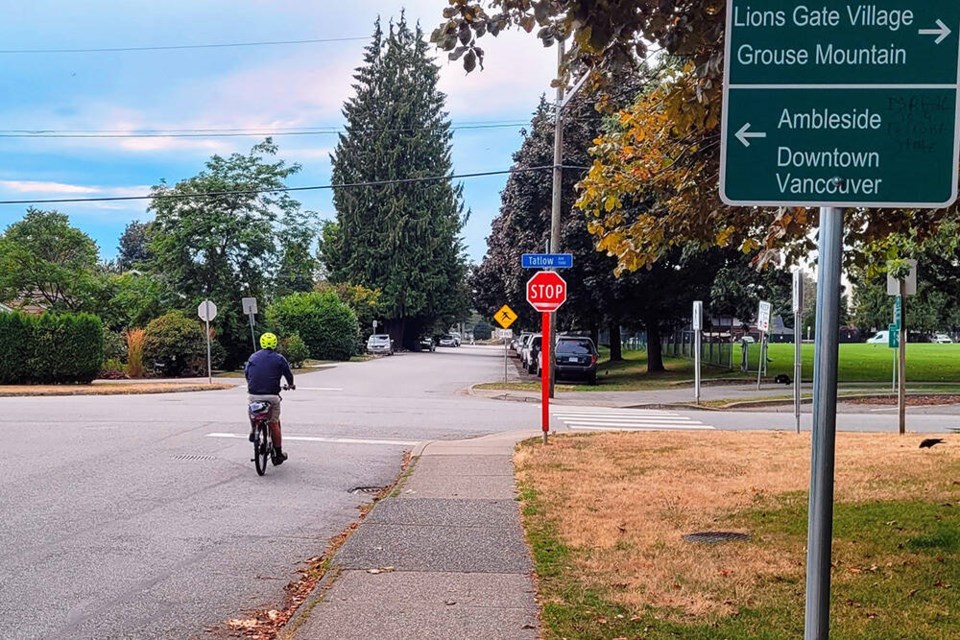Bike lanes don’t all have to be protected.
I hear the groans: “I thought you were a bike advocate.” “How could you say that?”
Let me clarify. There are many types of bike facilities. Your multi-use paths, like the Spirit Trail and the Green Necklace, mix pedestrians with rolling modes. Protected bike lanes like those on First Street and the new ones on Mount Seymour Parkway separate fast-moving vehicles from people on wheels.
Sharrows on roads like Chesterfield and St. Andrews mean that people on bikes “share” the road in line with people in cars. The sharrows on Marine Drive indicate that bikes can squish beside the curb. Painted bike lanes like those on Highlands Boulevard and East Keith Road designate a space for people on bikes.
Lastly, there are neighbourhood bikeways.
Municipalities create neighbourhood bikeways on streets with low vehicle volumes and speeds. People on bicycles share the road with motor vehicles. Because these routes are on low-traffic streets, you rarely meet a car. Signs, pavement markings, plus speed and volume controls discourage motor vehicles except for local traffic. Neighbourhood bikeways make up more than 80 per cent of bike facilities in Vancouver. But it’s a form we rarely create here on the North Shore – mainly in the District of North Vancouver.
15th Street, parallel to Marine Drive through Norgate, is an example of a neighbourhood bikeway. You can ride in the painted bike lane along traffic-choked Marine Drive or dip down to 15th to enjoy the quiet garden-lined street through an adorable hood. I know which I prefer. Even so, I’ve argued that this quiet street would benefit from becoming a non-through street to keep it calm during Marine Drive back-ups.
Neighbourhood bikeways cater to people of all ages and abilities. Studies from the Cycling in Cities program at the University of British Columbia have shown that neighbourhood bikeways are among the safest and most favoured biking infrastructure. They appeal to many people, from experienced cyclists who benefit from reduced car traffic to those who may feel uncomfortable riding along busier roads. It’s just that we don’t have many to experience on the North Shore.
Who rides up Capilano Road to Ridgewood to get to Edgemont Village when you can take the infinitely more enjoyable Paisley Road instead? This route is an obvious candidate for a neighbourhood bikeway. All it needs is some signs and a name. That’s way cheaper than building a protected bike lane along Capilano.
Don’t get me wrong. We need protected bike lanes on busy thoroughfares. Not everyone is heading for Edgemont, so Cap Road should have a safe bike facility. But we could also use a lot more neighbourhood bikeways. So cheap to create, so vastly more enjoyable to ride.
Here’s another bikeway idea: To get up to Lynn Canyon Park, why not ride Harold Road via the pass-through to Allen Road, then up Draycott to Duval and into the park? Or some combination of the calm streets in this area. Many might prefer a peaceful route over the more direct, busy Lynn Valley Road. Taking your young family up to the canyon on bikes should be fun and safe, not just safe. Again, some signs, a few curb letdowns, possible upgrades to the surfaces along pathways and maybe a name for this route would make it more apparent. People would love it.
We often develop direct routes on busy streets. If we want people to use alternate forms of travel, let’s also design bike routes that are fun, safe and lovable.
Heather Drugge is a sustainable transportation advocate who has used her bike for transportation for more than 20 years. She’s got an e-bike now, and maybe a jetpack next. [email protected]



